Medical innovation can help patients live longer, healthier, and more productive lives. Innovative medicines developed by America’s biopharmaceutical research companies have helped increase childhood cancer survival rates from 58% in 1970 to 83% today and have contributed to declining death rates for patients battling diseases such as HIV/AIDS (85% decline since 1995), heart disease (30% decline between 2001 and 2011) and cancer (22% decline since 1991), according to the Pharmaceutical Research and Manufacturers of America.
Today, pharmaceutical companies have more than 7,000 innovative drugs in development worldwide by biopharmaceutical companies and more than $500 billion has been invested in R&D since 2000, according to PhRMA.

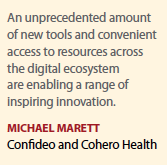 Thomson Reuters says the industry is enjoying the most innovative age in human history. Company analysts say the pharmaceutical industry continues to grow thanks to its branching into creative, new markets. Proof can be seen in the seven drugs expected to launch this year that Thomson Reuters predicts will achieve blockbuster sales status of more than $1 billion in revenue by 2020, with some predicted to hit $2 billion during that period.
Thomson Reuters says the industry is enjoying the most innovative age in human history. Company analysts say the pharmaceutical industry continues to grow thanks to its branching into creative, new markets. Proof can be seen in the seven drugs expected to launch this year that Thomson Reuters predicts will achieve blockbuster sales status of more than $1 billion in revenue by 2020, with some predicted to hit $2 billion during that period.
We are in a time of true innovation, says Kerrie Brady, chief business officer, Centrexion Therapeutics.
“It’s hard to pick just one innovation, as it’s constantly inspiring to learn about all the miraculous interventions, technologies, medications, and therapies that are being developed," Ms. Brady says. “If I did have to pick one, it would be the emergence of big data to more fully inform development of new drugs. The explosion of knowledge being published on a daily basis is a resource we need to be able to harness and machine learning is a great way to do that."
An organization must innovate to survive, says Donald Deieso, Ph.D., chairman and CEO, WIRB-Copernicus Group (WCG).
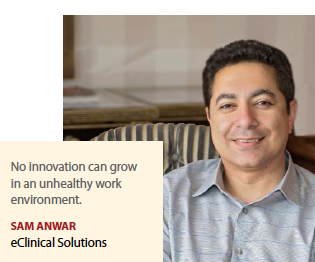 “Innovation, in its truest sense, is continuous process improvement," Dr. Deieso says.
“Innovation, in its truest sense, is continuous process improvement," Dr. Deieso says.
“Innovators are, by their nature, perfectionists. Great leaders do not wake up every morning and think, ‘How can I defend the status quo today?’ Instead, they wake up thinking, ‘We have to find a better way.’"
What companies want to do in the time they want to do it, costs a lot of money; that stops people, says Lisa Boyette, M.D., Ph.D., CEO, Curable.
“But innovation is a lot easier when you’re open to considering all of the paths that might lead to a desired outcome, and able to let go of biases about which variables should take priority," she says. “Fearlessness fosters innovation, not caring what people think, not worrying what might go wrong, what corrective action you might have to take. Innovation requires freedom from all the non-essentials, mental and real."
Incentives and funding to fuel innovation must not drain away, and organizations in basic research and in the biopharmaceutical industry must use the resources they do have to fund the next generation of breakthrough medicines for patients, says Thomas Large, Ph.D., senior VP, discovery and preclinical research at Sunovion Pharmaceuticals.
Factors Constraining Innovation
The industry has focused on closing the innovation gap for more than two decades through business and operating model shifts and restructuring initiatives. Companies have looked to silver bullet technologies such as the “omics," process re-engineering, Six Sigma initiatives, adaptive trials and more.
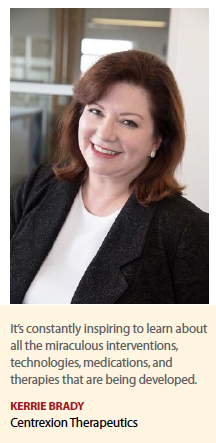 While these approaches have had a positive impact, spot measures, narrowly focused initiatives and incremental changes have not led to significant or sustained R&D productivity improvements.
While these approaches have had a positive impact, spot measures, narrowly focused initiatives and incremental changes have not led to significant or sustained R&D productivity improvements.
No one solution can bridge the R&D productivity gap, stress executives from Accenture. The future of pharmaceutical innovation demands, they say, a holistic approach that addresses every R&D dimension — strategy, process and organization, and funding.
Our PharmaVOICE 100 say fear of failure, a culture that accepts the status quo, outdated processes, and inertia can inhibit innovation.
“Fundamentally, while the pharmaceutical industry has some of the smartest employees of any other industry except from maybe the NASA types, and innovation clearly is key element of new product discoveries, this is not true for the clinical trial enterprise," says Jules Mitchel, Ph.D., president of Target Health.
“Part of it is due to a myth and misperceived fear that if ‘I do something wrong,’ whatever that means, I will get ‘dinged’ by the FDA with a 483 and then I will lose my job. This is where leaders must jump in with leadership, but to date we do not see it. We tell folks, if you are not sure about something in the clinical trial space, bring the FDA in as a partner and get the answer document."
Several of our PV 100 honorees mentioned that bureaucracy and process can stifle creativity as well.
“In my opinion, the top two constraints that prevent organizations from innovating are: rigid, outdated processes, because many organizations grew to worship processes as if they are the end goal, as opposed to being a method to reach the business goals; and corporate politics, because it creates a harmful work environment that leads to stress and mistrust and results in poor decision making," says Sam Anwar, VP, engineering, eClinical Solutions. “No innovation can grow in an unhealthy work environment."
A culture that accepts that “the way we do things" is the only way to do things, is a disincentive for people to speak up, says Julie Adrian, US managing Ddirector, Chicco Agency, inVentiv Health.
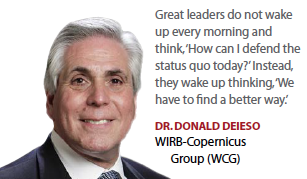 “Some organizations also send messages — inadvertently or not — that not succeeding is failing; in other words, just because a calculated risk didn’t pan out, it doesn’t mean you failed," she says. “Being unwilling to take a chance inhibits being innovative."
“Some organizations also send messages — inadvertently or not — that not succeeding is failing; in other words, just because a calculated risk didn’t pan out, it doesn’t mean you failed," she says. “Being unwilling to take a chance inhibits being innovative."
Brian Goff, executive VP and president of hematology at Baxalta, agrees, saying organizations that operate with functions and titles as most important versus an orientation around the patients we serve cannot possibly optimize its contribution to the community.
“Real patient focus is not superficial; it’s evident when a company is authentically fueled by patient-motivated innovation versus saying it because it sounds right," he says.
People quickly adapt and work around inefficiencies because challenging processes and finding solutions is time consuming, says Stephany Lapierre, founder and CEO of tealbook.
“Innovation requires people who are passionate enough to challenge the status quo and willing to take the risk to champion solutions," she says. 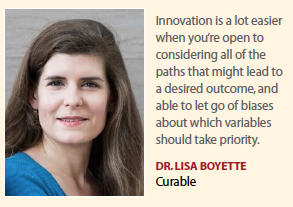 “Not everyone is a risk taker and most people are not truly encouraged to be innovative based on the cost of failure."
“Not everyone is a risk taker and most people are not truly encouraged to be innovative based on the cost of failure."
One key hurdle that impedes innovative thinking is the lack of a more strategic, long-term focus and mining of the needs of various stakeholders to drive simple, but genuinely innovative approaches, says Cindy Cetani, global integrity and compliance head, function, change, at Novartis.
“Together with this we need collaborations that may be counter to the way we have operated to this point," she says.
Inertia is one of the biggest things that can inhibit innovation in organizations today, says Valerie Kobzej, director, multiple myeloma marketing at Celgene.
“Sometimes we get so caught up in the way we have always done things that we don’t stop to think that there may be a better way to get even better results," she says.
Factors that Influence Innovation
Our industry leaders say an important part of fostering innovation is company culture that encourages innovations, supports risk taking, and removes the fear of failure.
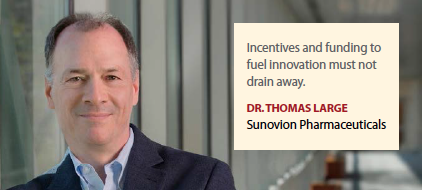 “Culture is at the heart of innovation," says William King, founder and chairman of Zephyr Health. “Ensuring people are not afraid of failure and have confidence to push boundaries results in amazing things that often people can’t imagine."
“Culture is at the heart of innovation," says William King, founder and chairman of Zephyr Health. “Ensuring people are not afraid of failure and have confidence to push boundaries results in amazing things that often people can’t imagine."
Mr. Goff agrees, saying: “I firmly believe that innovation is driven by a culture in which teams are empowered and expected to ask why and experiment. Another important aspect is diversity and having as many dimensions as possible. I’m especially proud that my leadership team is three-quarters women, represents every continent, is multi-generational, and covers a broad spectrum of personalities and work styles. I’m convinced that our innovation and performance is the direct result of this mix."
Accepting a diversity of opinions is important, says Paul Bolno, M.D., president and CEO of WAVE Life Sciences. “Companies have to create an environment that enables people to ‘fail forward’ rather than focus on fear of failure, enabling people to try and challenge new ideas."
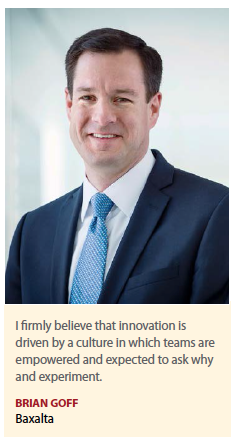 Gregg Fisher, founder and managing partner, The Stem, says innovation flows from several things, including identifying a clear unmet need or pain point of an existing process and recognizing how a new approach or technology can address that need or pain point, and applying it
Gregg Fisher, founder and managing partner, The Stem, says innovation flows from several things, including identifying a clear unmet need or pain point of an existing process and recognizing how a new approach or technology can address that need or pain point, and applying it
“Among the factors that support the innovation process are: a culture that celebrates calculated risk; smart failures; continuous learning, often in areas outside of what you know to open the mind to new solutions, examining how new technologies alter existing/entrenched processes; and spending time with customers to understand what’s broken," he says.
Our PharmaVOICE 100 industry leaders also say embracing risk and giving people opportunity to push boundaries can go a long way to encouraging innovation.
The greatest threat to strategy is rarely external; it usually comes from within the organization, says Amy Dowell, associate Partner, executive VP, strategy, HCB Health.
“I believe the four most powerful organizational anti-motivators for innovative thinking include denial, routine, peer influence, and seeking the path of least resistance," she says. “In my experience, every one of these sinister undercurrents keep organizations from thriving. I’ve seen this show up in the form of legacy thinking: ‘that’s not how we do this’ and ‘so-and-so will never get on board with this.’ I’ve also seen self-sabotage blamed on increasingly specialized and discreet functions within an org, ‘marketing owns this, but technically we have to get consensus from seven other teams, which will require more time and resources than we have available to us.’ In that case, path of least resistance wins. The only remedy I’ve seen powerful enough to derail these anti-motivators is a combination of tenacity in the project owner, and strong leadership to lift up tenacious teams and create access. “
Tone at the top, courage, curiosity, and a willingness to accept failure as a step along the way to success are all critical factors influencing innovation, says Catherine Angell Sohn, Pharm.D., president of Sohn Health Strategies.
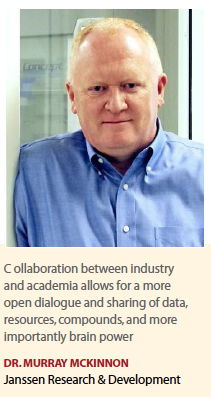 “It’s important to remain aware of the external environment, trends, and sources of innovation at universities and smaller companies," she says. “Focus on unmet needs and competitive benefit to be offered by your new products/service/technology."
“It’s important to remain aware of the external environment, trends, and sources of innovation at universities and smaller companies," she says. “Focus on unmet needs and competitive benefit to be offered by your new products/service/technology."
Organizations that successfully innovate are the ones that provide space to individuals and teams to be creative and to take risks, says Robert Willenbucher, M.D., head, cell therapy and head of Janssen Incubator, Janssen Research & Development, one of the Janssen Pharmaceutical Companies of Johnson & Johnson.
“What I mean by space is a circumscribed environment that is protected from the constraints imposed by the near-term needs of the mature business," he says. “Ideally, teams that operate in this ‘space’ have very clear objectives and receive ‘ring-fenced’ funding based on milestone achievement."
It’s important to encourage people to think out of the box and start with a clean slate in front of them, says Christina Hughes, senior VP and general manager, scientific services at Bracket.
“Everyone at the table must come from a place of yes," she says. “Once we have the ideas generated and prioritized, at a leadership level, your team needs to be supported financially and operationally in order to execute. It’s demoralizing to come up with great ideas and not be able to execute a single one."
Sandra Chase, VP, patient recruitment, Continuum Clinical, says people are the first and most important factor encouraging innovation.
“I’ve found that good ideas become great ideas when others’ thoughts and points of views are part of the process," she says. “Second, people need to have an open mind and welcome thinking that might be counter-intuitive at first, or may come from an unexpected discipline."
There has to be an environment that encourages innovation by recognizing that failure is a key component of innovation, says Alex Zapesochny, president and CEO of iCardiac.
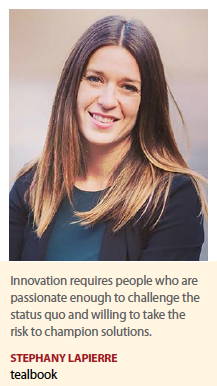 “Also, it’s important to find ways to experiment and innovate ‘cheaply’ in terms of both time and resources; this creates an iterative innovation feedback loop as new information is implemented into new ideas and experiments," he says.
“Also, it’s important to find ways to experiment and innovate ‘cheaply’ in terms of both time and resources; this creates an iterative innovation feedback loop as new information is implemented into new ideas and experiments," he says.
Murray McKinnon, Ph.D., VP, head of immunology discovery & Janssen Immunosciences at Janssen Research & Development, one of the Janssen Pharmaceutical Companies of Johnson & Johnson, says collaboration between industry and academia allows for a more open dialogue and sharing of data, resources, compounds, and more importantly brain power.
“Our challenges are significant and we need to bring the best and brightest together to tackle new and existing diseases," he says.
Technology has been the major catalyst for empowering and expediting innovation, says Michael Marett, founder of Confideo and chief commercial officer of Cohero Health.
“An unprecedented amount of new tools and convenient access to resources across the digital ecosystem are enabling a range of inspiring innovation," he says. “There are so many amazing companies and products I am fortunately affiliated with that are doing just this. The advent of the connected health, quantified self, and on-demand data platforms have been catalysts for many new companies. All are pertinent, primed for explosive growth and are empowering patients and stakeholders to be more informed, in real-time. Further, the evolution of virtual reality and 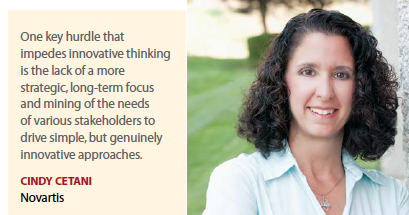 immersive media is transforming how content is consumed. This categorically represents brand new highly disruptive models for HCP and patient education."
immersive media is transforming how content is consumed. This categorically represents brand new highly disruptive models for HCP and patient education."
One example is cognitive computing, which can have a profound impact on the ability of people to access and experience care, and to greatly accelerate the entire discovery and development of new therapies, says Alison Little, principal, advisory industry leader for life sciences, KPMG.
“The diagnostic ability of a doctor or a scientist is no longer limited by his direct experience if he is supported by a cognitive solution," she says. “A cognitive system can learn from the experience of all the best experts and the results of all previous clinical trials and use. Cognitive is powerful because of its ability to take in vast quantities of data and to continuously learn from new input, more than any human ever could." (PV)

















